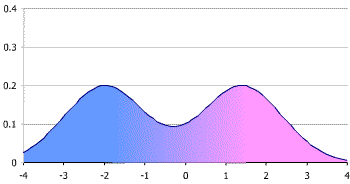Yes, Gender is a Social Construct, and…
We’ve all heard this phrase. There is an assumption that anything which is a social construct is, therefore, artificial, which ignores how social construction works

We’ve all heard this phrase. “Gender is a social construct” is a catchy little phrase, only five words, practically tailored for a bumper sticker or campaign button. It’s simplistic, easy to understand, and problematic when used as an ideological foundation element. There is an assumption that anything a social construct is, therefore, artificial, ignoring how social construction works.
Social construction is simply the joint development of understanding the world that forms our shared assumptions about reality. We socially construct meanings that we attach to words to communicate. The fun starts when one party alters the meanings behind a word without communicating that fully to others, breaking the shared assumptions and producing communication failures. This may occur by accident or with malicious intent.
I view gender as the social construct by which we perform a part of our identity which we wish ourselves and others to see. There are two pieces to this, the performance and the identity.
Breaking Down Gender: Gender Performance and Identity
The idea that gender is purely performative, that we ‘do’ gender solely for others, is a persistent oversimplification of a complex matter. It makes constructing philosophical cloudscapes much easier, but it is not reality.
We all know that our assigned sex at birth comes from what folks observe between our legs, the shape of bits of tissue that originate way back in the first few weeks of fetal development. A complex dance of messenger proteins and genetic origins is involved to produce this. There is a tremendous range of possible outcomes in measuring and describing these bits of tissue. Collections of such measurements from a population of humans will produce a “bimodal distribution,” a range of outcomes with two distinct peaks or normative values.

We, humans, love our dichotomies, binary classifications, and Either/Or choices. In the case of sex at birth, the social agreement is to ignore all the measurements that aren’t quite close enough to those normative values and pretend there are precisely two results. We are assigned one of these two socially constructed labels.
Many folks do not realize that much evidence points to a nugget of gender identity that is also formed, many weeks later in fetal development, deep in the structures of the brain that interface with the body. Again, a complex dance of chemistry and biology drives the production of the bits of neural tissue that hold this nugget of gender identity.
Sexual Differentiation of the Bed Nucleus of the Stria Terminalis in Humans May Extend into Adulthood
Almost all of the brain is essentially identical across male and female persons. There are several dimorphic regions with overlapping but slightly different average characteristics, mostly related to regions of the brain that handle body regulatory functions, olfaction, and visual-spatial skills. It’s also worth noting that very few people have measurements close to the normative values for their sex for all of these regions. We are all, it seems, a bit of a mixed bag.
The bed nucleus of the stria terminalis, a bit of the brain involved in reflexes and body movement control, is one of these dimorphic regions. Curiously, this region varies across gender identities. In the small number of samples dissected to date, the region appears similar in both natal and transgender men and is different in both natal and transgender women. This similarity between natal and transgender persons is present before any medical transition is done by the transgender person. Now, this is a correlation, not causation. Correlation doesn’t imply causation, but it waggles its eyebrows suggestively and gesture furtively while mouthing ‘look over there’.
This biological nugget of gender identity is problematic for much of Western philosophy and theology. For centuries, it has been widely argued that there is a Cartesian duality, a split between mind and body. This argument is a handy way to construct theological cloudscapes of the mind or spirit somehow being detachable or independent of the body, which in turn permits the argument that the mind is infinitely flexible in its independence, able to overcome any limits or issues of the body.
The popular interpretation of gender as purely a social construct is related to this mind/body duality. It enables the claim that gender arises from the infinitely flexible mind, and therefore gender is merely a socially imposed thing. Oh, and since the mind is infinitely flexible and separate from the body, it should be possible to apply conditioning to alter the mind’s idea of gender identity to match the body.
I argue that there isn’t a mind/body duality, but rather that the mind is part of the body, a sort of emergent phenomenon that arises from the operations of the brain, capable of learning and adjusting, indeed, but bound to the capabilities and characteristics of the brain and not infinitely malleable.
While I would agree that gender roles and gender presentation are certainly social constructs, I argue that gender identity is not but rather arises from the brain, a deeply seated phenomenon impacting the mind that develops in the brain.
If gender identity itself were merely another aspect of an infinitely malleable mind, then psychological persuasion or coercion techniques should be able to alter that gender identity. So-called “conversion therapy” would work, rather than simply terrifying the subject into concealing their gender identity. I know from personal experience that it does not work.
If gender identity was not seated in the depths of the brain but imposed from without, then changes in the imposing stimuli should cause the gender identity to change over time. Dr. John Money attempted this, most notably with the involuntary gender reassignment of the child David Reimer, which despite his initial claims, failed miserably.
John Money (8 July 1921 — 7 July 2006) was a New Zealand American psychologist, sexologist and author… (link to wikipedia.org)
David Reimer (born Bruce Peter Reimer; 22 August 1965 — 4 May 2004) was a Canadian man born male but reassigned female… (link to wikipedia.org)
Dr. Milton Diamond refuted Dr. Money’s claims that males and females were psychosexually neutral at birth, and that nurture could alter gender identity.
The John/Joan case was the unfortunate story of a set of normal identical male twins. They developed a penile condition called phimosis, which is a closing of the foreskin, so it becomes difficult to project the head of the penis. It can make it difficult to urinate and the closed foreskin can accumulate dirt and gunk. To correct this condition the boys were sent for circumcision. Instead of the circumcision being done with a knife and bell clamp as is typically done, it was done with a cautery, a device that basically uses a hot wire to cut. Surgeons often like to use such an instrument in surgery because the heat also closes off any cut blood vessels. In any case, there was an accident and the penis of the first twin was burnt off. For privacy sake, in our publication, we called him John when living as a boy and Joan when living as a girl. The parents anguished about the decision of “What to do now with John?” What could be done for a boy without a penis? The local physicians they consulted recommended he have later cosmetic surgery to fashion a penis. However, they saw Dr. John Money on television telling how a male (transsexual) can have surgery to live as a contented female. He was then consulted. His solution, with the basic idea that males and females were psychosexually neutral at birth, and any male without a penis would be better off living as a girl and then as a woman, led him to recommend that the child be given appropriate sex reassignment surgery and raised as a girl.
The parents followed Dr. Money’s advice. This sex reassignment included removal of the child’s testicles and scrotum, and preparing him, to have a vagina. The parents did the best they could to raise the child as a girl we called Joan. As the child grew up, however, Joan began to look around and say, “Well, they’re calling me ‘girl’ yet I’m more like my brother than I am like the girls around here.” “My parents are calling me girl and I have a girl’s name but I’m not like any girl I know. I think more like a boy and prefer to do boy things.” But there was a long transition stage before Joan would come to refuse to live any longer as a girl. First off, not only did Joan realize something was amiss, so did her school mates. They teased her for the incongruities between her male-like behaviors and her female-dress and appearance. They called her Gorilla since they saw the male in her behavior and demeanor. Finally, despite the absence of typical male genitalia and the administration of female hormones to induce breast growth and feminine hips and fat deposits, Joan decided she could no longer live as a girl. She had to live as a boy. After the switch she was called John instead of Joan. After the switch Joan was eventually received better as John than as the girl she had been led to believe she was.
With psychiatric help and hormone therapy in addition to the surgical removal of his breasts and construction of a penis, John developed into a mature man, married in his twenties and adopted his wife’s children.
— “A Conversation with Dr. Milton Diamond”, Dean Kotula, Pacific Center for Sex and Sexuality (2011)
Unfortunately, at age 38, David Reimer committed suicide after suffering from severe depression.
Gender identity can reassert itself despite social pressures. If not congruent with the gender role or presentation imposed by society, it can result in considerable discomfort, as some of us have experienced.
Yes, gender is a social construct, and gender performance is the socially agreed upon means I use to express my gender identity. This fragment of my identity is informed by a few bits in my brain near the hypothalamus formed late in fetal development.
I perform my gender not to please society or to please others, but to be in alignment with my persistent gender identity. I have built a gender role and presentation for myself that removes my discomfort and better aligns the elements of my gender.
While I have gone to some lengths to explain my conceptualization of the origin of my gender identity, how I come to be this way is far less important than understanding that I am, that I exist, and that the identity that I hold and express is valid, my truth, and dwells as part of the core of my identity.
As one social construct to another…
I see no reason to hide my truth, to pretend to be that which I am most emphatically not, simply to live my life in this world. I expect to continue living and loving my life far into my future.
A new intersectional publication, geared towards voices, values, and identities! aninjusticemag.com

No comments:
Post a Comment